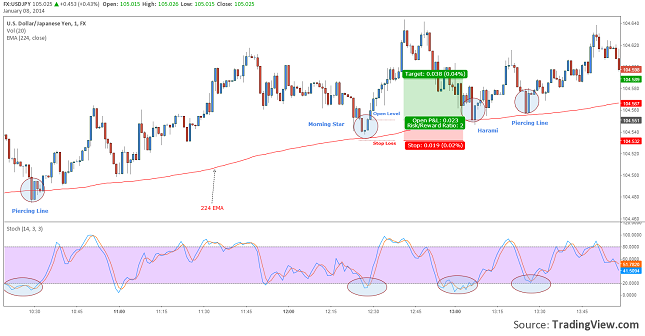As we said it before, scalping could be a good way to make some fast money, especially if you don’t have too much time to spend in front of your PC as a trader. But to stay on a good a profitable path, in time you should test several forex scalping systems before trading your real money.
In our trading experience we observed that there really are trading strategies that do not have to be complex or hard to be applied to make money. Sometimes there are simple strategies that help traders get to constant profits. And the probability for this to happen rises with a good money management system applied to a simple strategy.
We back tested and live tested the following strategy and now we are putting it on our website for you to test and give us your feedback. It is a pretty simple strategy that uses a slow EMA and a default Stochastic (which is actually pretty fast, comparing it to the EMA) on a 1 minute USDJPY chart.
Why USDJPY? We saw in our testing that this currency pair gave us the best results without making many changes to the initial strategy. This major FX pair it is usually trending and has a medium volatility. Taking these into consideration we can say that it is a medium risk pair and can be used easily with a scalping strategy.
Let us now get to our strategy:
[sociallocker]
- We used a 224 EMA on a 1 minute time frame. The slow EMA sets the trend and we used it as a support line, betting on a bounce after the price hits it.
- Stochastic (14, 3, 3) on 1 minute chart. It is a default Stochastic, which has given pretty good signals. We were looking for oversold/overbought signals when the price touched the EMA.
- For even better filtering we also looked for Candlestick patterns to raise the probability for a good entry.
In our example, you can see that the 224 EMA is below the price, meaning that the trend is up. In this case it is important to wait for pullbacks to the moving average. It will offer support, but to have better buying signals we should also look if the Stochastic fell in an oversold area and comes back (giving also a buying signal) and if we have a Candlestick pattern.
If these three conditions are met (see the second example with the Morning Star) we can enter a trade right after the Candlestick pattern is confirmed (on the opening of the next candle). Set a Stop Loss below the pattern and below the EMA and a Take Profit at a distance 2 times further than the Stop Loss. This way you will have also a positive money management.
It is important for the price to get very close to the EMA, or even better to touch or cross the moving average. This way it will assure you a tighter and safer Stop Loss.
Changes can also be made to the strategy. Instead of using Candlestick patterns you can also use price patterns like Double Bottoms, Rectangles and triangles. These kinds of patterns usually give stronger signals, but you will need to have patience and wait for them to be drawn. Another change would be divergences on the Stochastic. Instead of simple overbought/oversold, this oscillator also makes divergences and these are also stronger signals of reversal.
We gave only an example on an uptrend, but the strategy works as well on a downtrend, you will just have to see the 224 EMA above the price, wait for overbought signals from the Stochastic and see Bearish Candlestick Patterns.
[/sociallocker]
Previous << What Are the Recommended Trading Hours for Scalping ? <<
Next >> Top 3 Questions A Scalper Should Know The Answer To Today >>
EMA And Stochastic Scalping Strategy For USDJPY by Razvan Mihai



